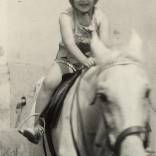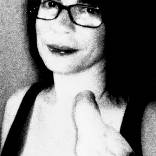My Promenade
Jenny Martin
When I was five, growing up in Beirut, Lebanon in 1966, I rode a horse for the first time. He was big, at least seven feet tall, and snow white, with big dark eyes, just like the horses in my fairytale book. His name was Haram. A lady with bright yellow hair and big blue sunglasses lifted me up, way up, and set me down in the saddle. She put the reins in my hands, said “Enjoy your promenade, dear!” and we were off.
Until that day I had never been allowed to ride a horse. My three older sisters rode every week, on chestnut and dappled-grey stallions with arched necks and flowing manes. They cantered, and jumped, and took long Sunday promenades over the dunes and along the beaches of the Mediterranean while I stayed behind in the dusty barnyard, my only companion a swaybacked mule named Humphrey, who was tethered to a stake on a six foot chain.
I knew how Humphrey felt.
But, on the day of my promenade, Haram and I rode for a long, long time, leaving my sisters and Humphrey far, far behind. We went down a dirt road and into the trees. We passed by a large group of people having an outdoor party. I could tell it was a party, because there were tents and campfires and all the women wore long dresses and fancy scarves. A little girl with dark curly hair left the party and came running up to me. She held out her hands, like she expected a present, so I figured it was her birthday party. I couldn’t understand what she was saying, and besides, I was a fairytale princess riding to a castle on my snow white stallion, so I just looked away and kept on riding, out of the forest, across the sand dunes, and back to the stable, where I gave Haram a sugar cube, kissed his soft rubbery nose, and told him how much I loved him, and promised to love him forever and ever.
My mother pulled out her Kodak Instamatic and took a photograph.
It is black and white, dated May 1966. On the back there is a penciled message in my mother’s handwriting: “Note healing scars on Haram – when Mrs. Mann found him he was down – couldn’t get up and almost ‘out’.”
The horse I rode on the day of my promenade had been beaten, starved, and left in the desert to die. He was an Arabian, one of the oldest horse breeds, with origins in the Arabian Peninsula dating to 2500 BC. Arabians were highly prized by the nomadic Bedouins for their endurance, strength, and sensitivity. Bedouin legend claims the Arabian was created by Allah from the four winds—spirit from the North, strength from the South, speed from the East, and intelligence from the West. The white horse was found lying in the dunes, with pockets of maggots writhing in open sores on his hips and shoulders. His tongue, sliced nearly in half from an ill-fitting bit, protruded from his lips. He had been a workhorse, one of many dragging fruits, vegetables, and kerosene tanks on wooden carts though the streets of Beirut; his skin bore scars from slashing whips and biting leather traces. Exhausted cart horses sometimes collapsed between the shafts; when this happened, the animals were simply unhitched and left to die where they fell.
The woman who lifted me into the saddle on the day of my promenade was named Sunnie Mann. Earlier that year she came upon the half-dead horse while riding across the dunes of Southern Lebanon. She brought him back to her riding academy on the outskirts of Beirut, named him Haram—an Arabic term for “sacred”—and nursed him back to health. A British expatriate, Sunnie ran the Horses and Hounds riding school for over 40 years, teaching proper horsemanship to the political elite of Beirut even as Palestine Liberation Organization guerillas and Lebanese Christian Phalangists bombed and bloodied one another in the streets. She held on through the early phases of the Lebanese Civil war, but eventually closed the academy in 1982, after Israel Defense forces invaded southern Lebanon in Operation Peace for Galilee, a military campaign which left over 20,000 dead. In 1989, Sunnie’s husband Jackie Mann was kidnapped on his way to the bank and held hostage for more than two years by an Islamic terrorists group linked to the Hezbollah. While in captivity, the 74-year-old man was placed in solitary confinement, manacled to the floor, and beaten.
The girl I saw on the day of my promenade, with dark curls and outstretched hands, lived in Shatila, a camp for Palestinians who sought refuge in Lebanon following the 1948 Arab-Israeli conflict. The refugees lived in canvas tents and lean-to shelters made from flattened oil barrels and corrugated tin. Women baked bread over glowing coals and strung laundry between tree trunks. Dogs stretched out in the red dirt, their ears engorged with ticks and their backsides encrusted with tapeworms. Children scampered barefoot beneath the pines, dodging smoldering piles of refuse. When the wealthy women of Beirut passed through the camp on horseback, they sometimes pulled sugar cubes from their riding coats and tossed them into the children’s outstretched palms.
In the mid-1960s, hundreds of Palestinians lived among the umbrella pines of the Shatila camp; today, more than 12,000 registered Palestinian refugees live in the camp’s concrete apartments and cramped alleyways. On September 16, 1982, the Lebanese Christian militia and the Israeli army sealed off the entrances and raided the camp; by September 18, over 1,000 of Shatila’s men, women, and children had been killed in what is widely regarded as the worst atrocity in Lebanon’s fifteen-year civil war. Loren Jenkins, a Washington Post reporter who entered the camp on September 23rd, described the aftermath of the massacre: “Women wailed over the deaths of loved ones, bodies began to swell under the hot sun, and the streets were littered with thousands of spent cartridges. Houses had been dynamited and bulldozed into rubble, many with the inhabitants still inside. Groups of bodies lay before bullet-pocked walls where they appeared to have been executed. Others were strewn in alleys and streets, apparently shot as they tried to escape.”
On the day of my promenade, I didn’t know about massacres, or hostages, or Hezbollah, or Allah. I didn’t know that a stable hand had taken us a few hundred yards off Sunnie Mann’s property, that he had cut through a Palestinian refugee camp while leading us back to the riding academy, and that the entire promenade had lasted less than ten minutes. I didn’t notice that Haram had long black scars on his flanks and shoulders, that his head drooped, and that he stumbled rather than walked, over the hot sand. I only knew that I was a fairytale princess riding a snow white stallion toward the Promised Land, and that freedom tasted sweet, so sweet, like sugar on my tongue.





